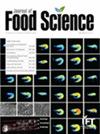China possesses abundant species resources in genus Lithocarpus Blume, commonly known as “acorns.” These nuts are traditional foods in China, holding significant potential for local specialty food and rural economic development. To explore their edible value, we compared the nutritional components and metabolites between the fruits of Lithocarpus corneus (YD) and Lithocarpus pachylepis (HL), which are cultivated widely in south of China. Non-targeted metabolomics analysis of YD and HL was performed using ultra-performance liquid chromatography tandem mass spectrometry technology. A total of eight classes of differential metabolites (DAMs) were detected: alkaloids, amino acids and peptides, carbohydrates, fatty acids, polyketides, shikimates and phenylpropanoids, terpenoids, and other metabolites. In the positive ion mode, 225 DAMs were identified, whereas in the negative ion mode, 116 DAMs were identified. KEGG pathway enrichment analysis showed that the differentially abundant metabolites were generally enriched in three pathways: aminoacyl-tRNA biosynthesis, alanine, aspartate, and glutamate metabolism, and ABC transporters. The nutritional content of YD has higher moisture, fructose, and total flavonoid levels, but lower starch, protein, fat, glucose, sucrose, and total sugar content than HL. Additionally, YD contains more Ca, K, P, and Fe, but less Mg and Zn compared to HL. Analyses indicate that YD is nutrient-rich and beneficial, making it suitable for further development. Two species of Lithocarpus contain nandrolone, suggesting a new direction for specialty food development. The unique chemical composition and rich nutritional content of Lithocarpus fruits provide a theoretical basis for their development and application as food resources.
L. corneus and L. pachylepis are traditional Chinese nuts, rich in starch, minerals, and flavonoids, making them suitable for consumption or use as food constituents. Their fruits contain various unique natural chemical compounds, indicating high application value and development potential.


